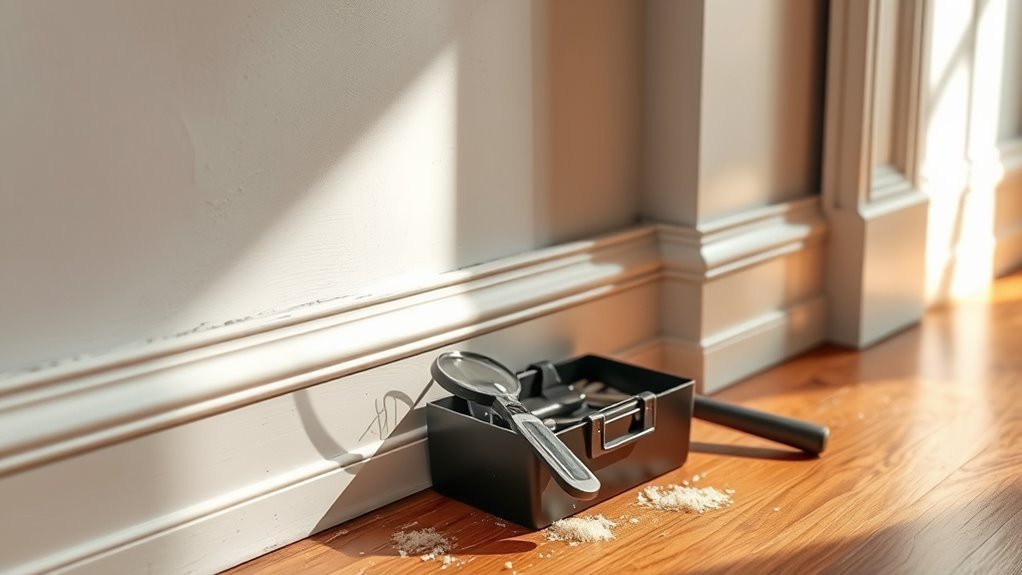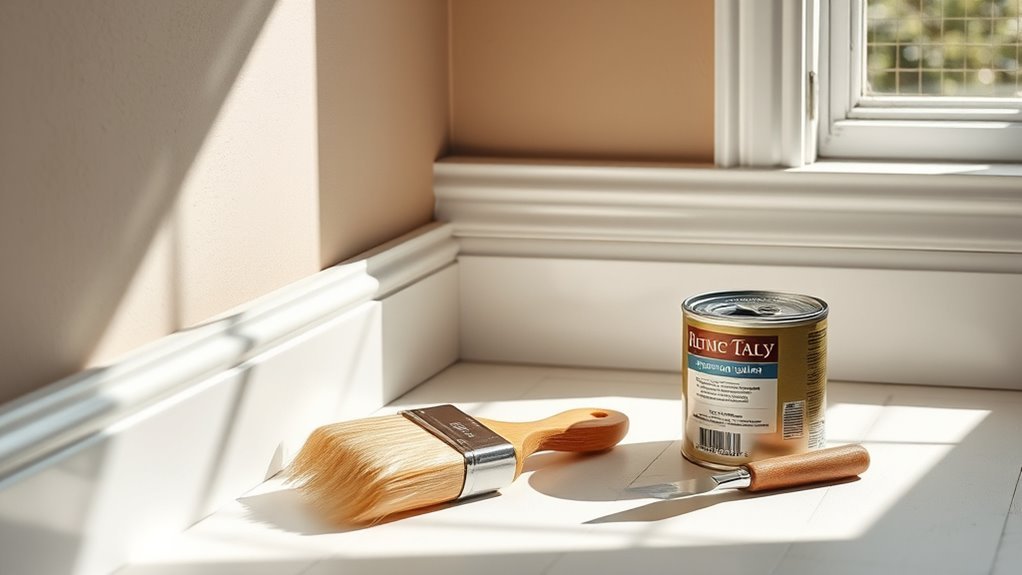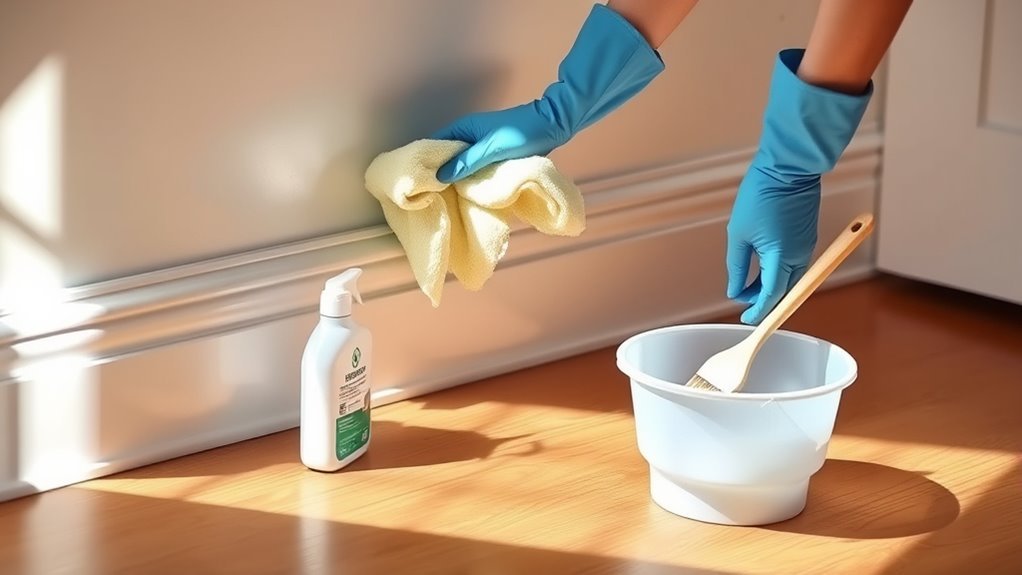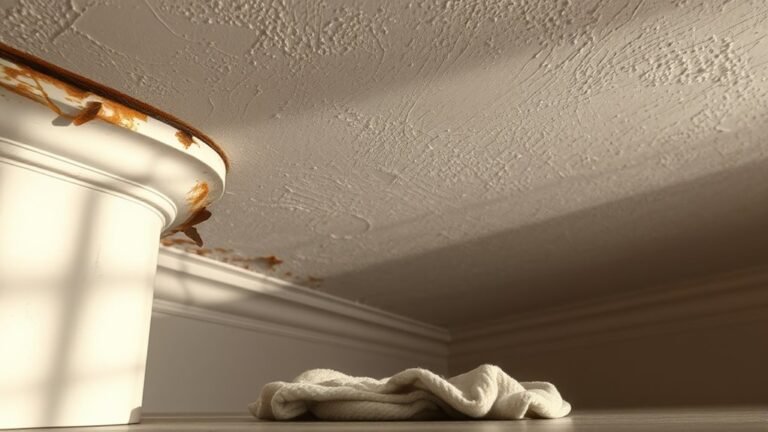Seasonal Maintenance Tips for Baseboards
You should inspect your baseboards regularly for cracks, gaps, and water damage to catch problems early. Clean them often with mild detergent and a soft cloth, tailoring methods to wood, vinyl, or metal. Repair chips with wood filler and repaint using durable, semi-gloss finishes. Protect against moisture by sealing gaps and ensuring good ventilation. Avoid pushing furniture directly against them, and consider corner guards in busy spots. Keep these tips in mind, and you’ll find even more ways to maintain your baseboards year-round.
Inspecting Baseboards for Damage

Before you begin any repairs or painting, you’ll want to carefully inspect your baseboards for damage. Regular inspections are your key to maintaining freedom from costly fixes down the line. By routinely checking your baseboards, you catch small problems early—like cracks, warping, or water damage—that could lead to bigger headaches if ignored. When identifying issues, pay close attention to discoloration, loose sections, or gaps between the baseboard and wall. This proactive approach saves you time and money, giving you control over your space without unexpected surprises. Keeping an eye on your baseboards lets you tackle repairs on your own schedule, so you’re never trapped by urgent maintenance. Regular inspections empower you to maintain your home confidently and freely.
Cleaning Techniques for Different Materials
After you’ve inspected your baseboards and addressed any damage, the next step is to clean them properly. Different materials call for specific cleaning techniques to keep your baseboards looking fresh without causing harm. For wood baseboards, use a mild cleaning solution and a soft cloth to avoid stripping the finish. Vinyl and laminate baseboards handle gentle soap and water well—just be sure to dry them thoroughly to prevent warping. Painted baseboards need a gentle touch; opt for a non-abrasive cleaner and a soft sponge. Metal baseboards benefit from a specialized cleaner to prevent tarnishing. Composite baseboards are versatile but still require mild cleaning solutions and non-scratch maintenance tools. Tailoring your approach guarantees your baseboards stay in great shape, giving you freedom from frequent replacements or costly repairs.
Removing Scuff Marks and Stains

When scuff marks and stains appear on your baseboards, they can quickly make a room look untidy. For effective scuff removal, start with a soft cloth and a gentle cleaner, like a mixture of warm water and mild dish soap. Gently rub the marks until they fade. For tougher stains, try a magic eraser but test it first on an inconspicuous spot to avoid damage. Stain treatment should always match your baseboard material—wood needs a different approach than painted surfaces. Avoid harsh chemicals that could strip paint or finish. By addressing scuffs and stains promptly, you maintain a clean, fresh look and keep your home feeling open and inviting. Your baseboards will thank you for the care, making your space truly yours.
Repairing Chips and Cracks
Keeping your baseboards free of scuffs and stains is just one part of maintaining their appearance. To keep your space feeling open and fresh, repairing chips and cracks is vital. Here’s how you can tackle this:
- Inspect your baseboards regularly for any signs of chipping or cracking.
- Use a quality wood filler or putty to carefully fill in any cracks or chips.
- Smooth the surface with fine sandpaper once the filler dries to guarantee a seamless finish.
- Apply a protective sealant to help with chipping prevention and extend the life of your repair.
Repainting and Touch-Ups

When it’s time to refresh your baseboards, picking the right paint can make all the difference. You’ll also want to prep the surface properly to guarantee smooth, lasting results. Finally, applying even coats will help you achieve a clean, professional finish.
Choosing the Right Paint
Selecting the right paint is essential for achieving a smooth, durable finish on your baseboards. When choosing, consider these key aspects to maintain freedom over your home’s style:
- Paint finishes: Opt for semi-gloss or satin finishes—they offer durability and are easy to clean, perfect for baseboards.
- Color selection: Stick to neutral tones for versatility, or pick bold colors to make a statement.
- Quality matters: Invest in high-quality paint for better adhesion and longevity.
- Compatibility: Verify the paint works well with your existing baseboard material to prevent peeling or cracking.
Surface Preparation Techniques
Before applying your chosen paint, proper surface preparation guarantees a smooth and long-lasting finish on your baseboards. Start by using effective sanding techniques to remove old paint, smooth imperfections, and create a surface that paint can grip. Then, apply a suitable primer to seal the wood and enhance paint adhesion. This step guarantees your paint job lasts and looks fresh longer. Here’s a quick guide to keep your prep work straightforward and effective:
| Step | Tool/Material | Purpose |
|---|---|---|
| Sanding | Fine-grit sandpaper | Smooth surface, remove flaws |
| Cleaning | Damp cloth | Remove dust and debris |
| Primer Application | Quality primer | Seal wood, improve adhesion |
| Drying | Time & ventilation | confirm primer is fully dry |
Following these steps sets you free from future touch-up hassles.
Applying Even Coats
Anyone aiming for a flawless finish knows that applying even coats is key to repainting and touch-ups on baseboards. To keep your baseboards looking sharp and maintain your freedom from constant repairs, focus on these essentials:
- Choose the right brush techniques—use long, smooth strokes to avoid streaks and buildup.
- Check paint consistency; thin paint spreads easily, but too thin can drip, while thick paint may clump.
- Apply multiple thin coats rather than one thick one for better coverage and durability.
- Allow proper drying time between coats to guarantee a smooth, even finish.
Mastering these steps lets you enjoy beautifully maintained baseboards without hassle, giving you the freedom to focus on what truly matters.
Preventing Moisture Damage
Although baseboards are often overlooked, preventing moisture damage is essential to maintaining their appearance and durability. You can keep your baseboards free from warping and mold by focusing on humidity control and installing effective water barriers.
| Tip | Benefit |
|---|---|
| Use a dehumidifier | Reduces excess moisture |
| Seal gaps | Blocks water seepage |
| Ventilate rooms | Prevents condensation buildup |
| Inspect regularly | Catches issues early |
Protecting Baseboards From Pets
If you have pets, you know how easily they can damage baseboards with scratching, chewing, or accidents. To keep your baseboards looking great and protect your freedom to enjoy your space, consider these pet proofing strategies:
- Choose durable baseboard materials like PVC or hardwood that resist chewing and moisture.
- Apply clear, pet-safe protective coatings to shield surfaces from scratches and stains.
- Use corner guards or protective strips in high-traffic pet areas to prevent damage.
- Train pets early to avoid baseboard interaction, reinforcing positive behavior with treats.
These steps help preserve your baseboards while letting your pets roam free. By combining smart materials and practical strategies, you’ll maintain both style and function without sacrificing your lifestyle.
Seasonal Deep Cleaning Schedule
When you schedule seasonal deep cleaning for your baseboards, you’ll prevent dirt buildup and extend their lifespan. To make this easy, use seasonal checklists that include specific tasks like dusting, scrubbing, and touching up paint. Setting cleaning reminders on your phone or calendar keeps you on track without feeling tied down. Focus on accessible tools such as microfiber cloths and gentle cleaners to maintain your baseboards’ finish without hassle. By sticking to a straightforward seasonal deep cleaning schedule, you free yourself from last-minute scrambles and maintain a fresh, polished look year-round. This simple routine gives your space a clean, cared-for vibe while keeping your baseboards in top shape effortlessly.
Tips for Maintaining Baseboards in High-Traffic Areas
In high-traffic areas, you’ll want to clean your baseboards more often to keep dirt and scuffs at bay. Using gentle but effective cleaning techniques can prevent buildup without damaging the paint or material. You should also take simple steps to protect the baseboards from bumps and scratches that happen regularly.
Frequent Cleaning Techniques
Because baseboards in high-traffic areas collect dust and scuff marks quickly, you’ll need to clean them regularly to keep them looking fresh. Using the right cleaning tools and best practices can make this task simple and effective. Here’s how you can maintain your baseboards freely and efficiently:
- Use a microfiber cloth or a soft brush attachment on your vacuum to remove dust without damage.
- Prepare a gentle cleaning solution with warm water and mild detergent for wiping away grime.
- Focus on small sections, drying each immediately to prevent moisture buildup.
- For stubborn scuffs, a magic eraser works wonders without harsh scrubbing.
Damage Prevention Methods
Although regular cleaning keeps your baseboards looking good, preventing damage is just as important—especially in busy areas. To protect your baseboard materials, consider installing corner guards or protective strips where scuffs and bumps happen most. Choose durable materials like PVC or metal in high-traffic zones; they resist dents and scratches better than softer woods. Seasonal weather changes can cause wood baseboards to expand or contract, so sealing gaps and cracks before winter or summer helps maintain their integrity. Also, avoid pushing heavy furniture directly against baseboards—use protective pads or sliders instead. By taking these simple steps, you’ll keep your baseboards free from damage and maintain the freedom to move around your space without worry.
Frequently Asked Questions
What Are the Best Tools for Installing New Baseboards?
When you’re installing new baseboards, having the right baseboard installation tools is key. You’ll want a miter saw for the best cutting techniques, letting you make precise angled cuts easily. A nail gun will speed up attaching the boards, while a measuring tape and level guarantee everything fits perfectly and stays straight. Don’t forget a pry bar and wood filler for adjustments and finishing touches. Using these tools gives you freedom to create a clean, professional look.
How Do I Choose the Right Baseboard Style for My Home?
Choosing the right baseboard style for your home feels like picking the crown jewel of your décor! You’ll want to contemplate your personal vibe—traditional styles bring timeless charm and warmth, while modern designs offer sleek, minimalist freedom. Think about your room’s architecture and your own taste; don’t let trends box you in. Ultimately, choose what makes you feel at home, because your space should celebrate your unique style and spirit.
Can Baseboards Be Made From Eco-Friendly Materials?
Absolutely, you can choose baseboards made from sustainable materials that reduce environmental impact. When you pick eco-friendly baseboards, you’re not just enhancing your space—you’re also supporting a healthier planet. Materials like bamboo, recycled wood, or reclaimed timber offer great durability and style without compromising nature. Embracing these options gives you the freedom to create a beautiful home that aligns with your values and commitment to sustainability.
How Do I Safely Remove Old Baseboards Without Damaging Walls?
Did you know that 60% of DIYers damage walls during baseboard removal? To avoid this, start by scoring the caulk line with a utility knife—this prevents paint peeling. Use a pry bar with a wide putty knife as a buffer to protect your walls. Slowly and gently apply removal techniques, working in small sections. Taking your time means you keep your walls intact and maintain your freedom to redesign without setbacks.
What Are Common Causes of Baseboard Warping Besides Moisture?
Besides moisture, you’ll often find baseboard warping caused by temperature fluctuations, which make the wood expand and contract unevenly. If your baseboards weren’t installed properly, like if they weren’t nailed or glued securely, that can lead to warping too. You want to make sure your baseboards have room to move slightly and are attached well, so they stay straight and keep your space looking fresh and free from annoying distortions.






